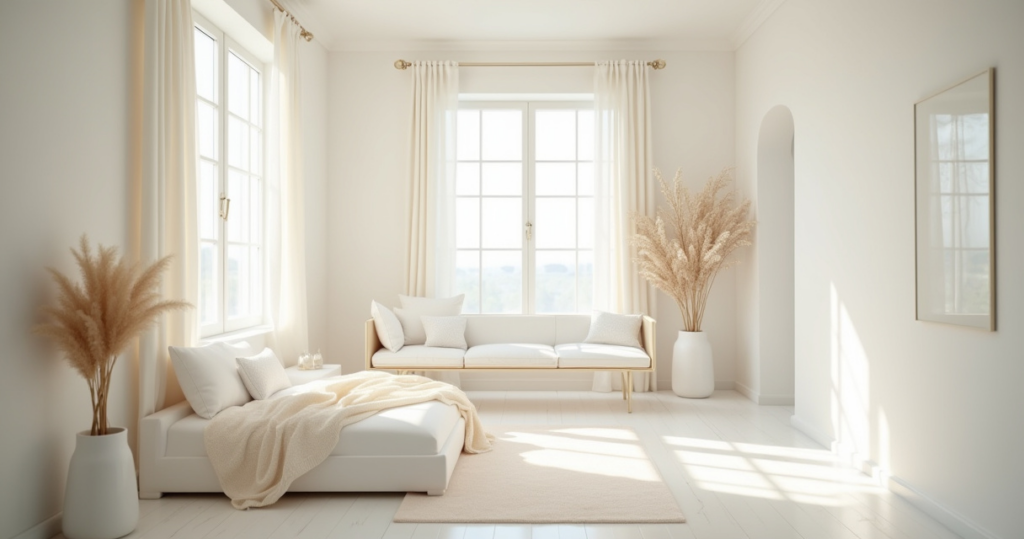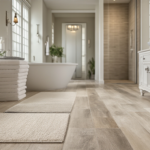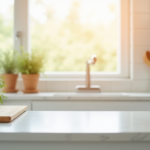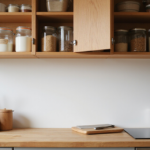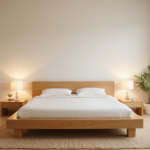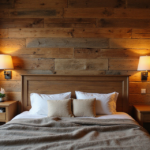Your bedroom should feel like a personal retreat—a space where you can unwind, recharge, and truly be yourself. But if you’re working with limited square footage, creating that perfect sanctuary can feel like an uphill battle. Between cramped quarters, poor lighting, and the challenge of making everything fit, small bedrooms often end up feeling more like storage closets than restful havens.
Here’s where the transformative power of white bedroom walls comes into play. Far from being a boring or sterile choice, white walls are actually one of the most strategic design decisions you can make for a compact space. They’re the secret weapon that interior designers use to make rooms feel twice their actual size, brighter than ever, and infinitely more versatile.
Whether you’re dealing with a studio apartment, a tiny guest room, or just a bedroom that feels perpetually cramped, these 18 brilliant strategies will show you exactly how white bedroom walls can revolutionize your space. Get ready to discover how this seemingly simple color choice can unlock your room’s hidden potential and create the airy, spacious bedroom you’ve been dreaming of.
1. Bounce Light Around Your Small Room
White bedroom walls act like mirrors for natural light, reflecting and amplifying every ray that enters your space. This isn’t just about making things brighter—it’s about fundamentally changing how your room feels. When light bounces off white surfaces, it fills dark corners, eliminates harsh shadows, and creates an even, welcoming glow throughout the entire room.
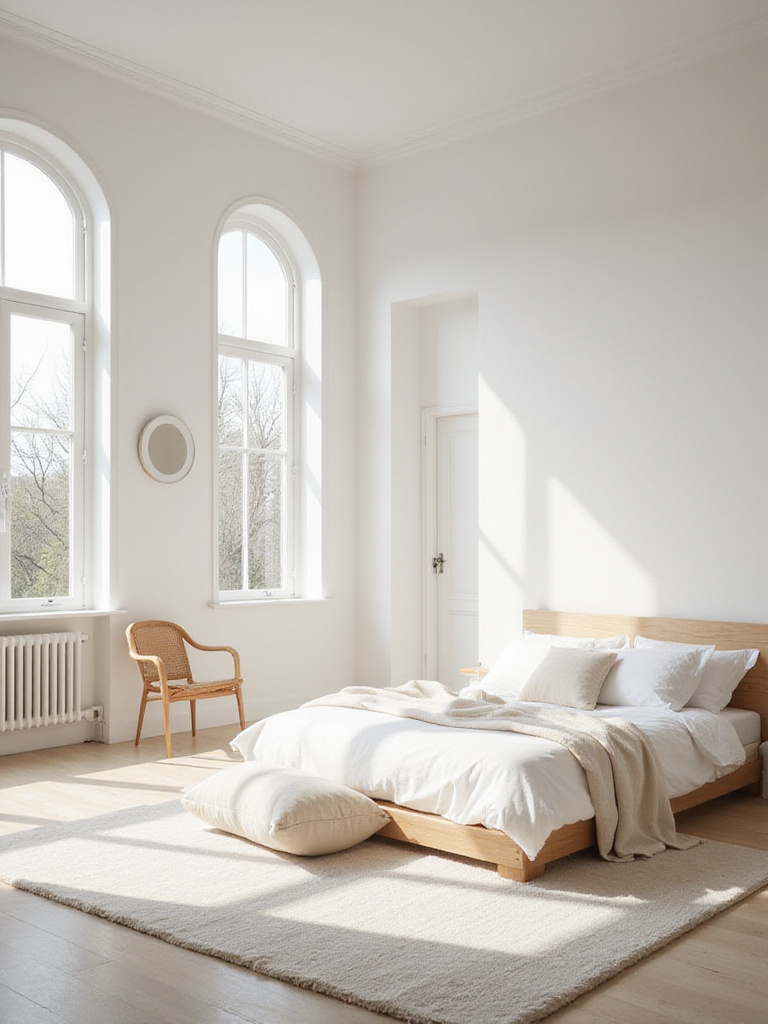
The science behind this transformation is impressive. White paint typically has a Light Reflectance Value (LRV) of 85% or higher, meaning it reflects nearly all the light that hits it back into your space. Compare this to darker colors that absorb light, and you’ll understand why white walls can make a north-facing room feel as bright as one with southern exposure. This reflected light doesn’t just improve visibility—it tricks your brain into perceiving the space as larger and more open.
- Choose an eggshell or satin finish to add subtle light reflection without glare
- Position mirrors strategically across from windows to amplify the bouncing effect
- Keep window treatments light and airy to maximize natural light penetration
- Remove heavy, dark furniture that absorbs light and creates visual weight
What makes this approach special is the way light interacts with different textures throughout the day, creating an ever-changing canvas that keeps your small space feeling dynamic.
2. Make Your Ceiling Disappear Visually
When you paint your bedroom walls the same crisp white as your ceiling, something magical happens—the boundaries between surfaces start to blur. This visual trick eliminates the harsh lines that typically define where walls end and ceilings begin, creating an uninterrupted flow that makes your room feel infinitely taller and more expansive.

This technique works because our eyes naturally follow continuous color planes. Without contrasting lines to define the room’s actual dimensions, your brain struggles to pinpoint exactly where the space ends. The result is a floating, cloud-like sensation that makes even eight-foot ceilings feel lofty and open. Professional designers often use this strategy in luxury hotels and high-end condos to maximize the perceived value of smaller rooms.
- Use the same white paint color and finish on both walls and ceiling for seamless flow
- Extend the white down to your baseboards for an even more dramatic effect
- Choose recessed lighting to avoid breaking the visual plane with hanging fixtures
- Paint any exposed beams or architectural details the same white to maintain continuity
The interplay between the colors creates a sophisticated backdrop that allows your carefully chosen furniture pieces to truly command attention.
3. Create a Perfect Canvas for Bold Furniture
White bedroom walls transform your space into a gallery where every piece of furniture becomes a work of art. This neutral backdrop allows you to invest in statement pieces that would overwhelm a room with busy or colorful walls. Whether it’s a vintage velvet headboard, a sleek modern dresser, or an antique wooden chest, white walls ensure these pieces get the attention they deserve.
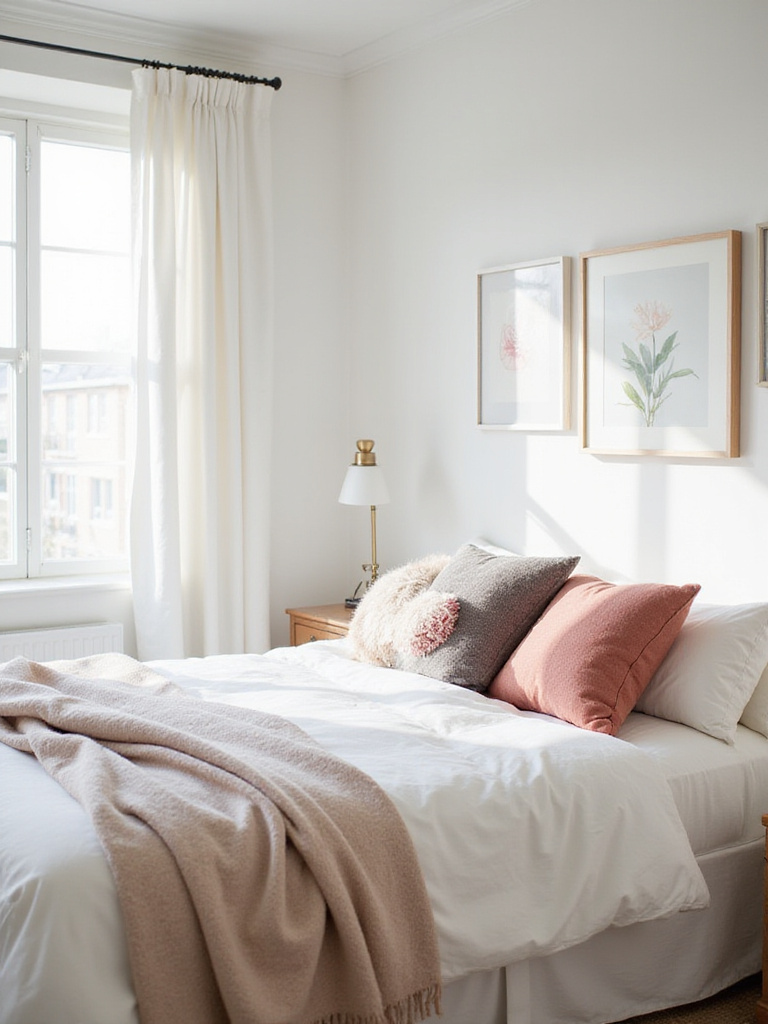
The contrast principle is what makes this so effective. When you place a richly textured or boldly colored piece against a pure white background, it immediately becomes the focal point. This allows you to use fewer, higher-quality pieces to achieve maximum impact—a crucial strategy when working with limited space. Instead of filling your room with multiple small items, you can let one or two stunning pieces define the entire aesthetic.
- Select furniture with interesting textures like boucle, rattan, or reclaimed wood
- Choose pieces in rich, saturated colors that pop against white backgrounds
- Invest in multi-functional furniture that serves as both storage and statement pieces
- Position your boldest piece where it’s visible from the doorway for immediate impact
The challenge of awkward spaces becomes easier when you have a foundation that works with virtually any style direction you want to explore.
4. Switch Styles Without Repainting
One of the most liberating aspects of white bedroom walls is their chameleon-like ability to adapt to any design direction. Whether you’re currently loving the minimalist Scandinavian look but dreaming of a maximalist bohemian vibe, white walls make these transitions seamless and budget-friendly. You can completely transform your room’s personality simply by swapping out textiles, accessories, and a few key furniture pieces.
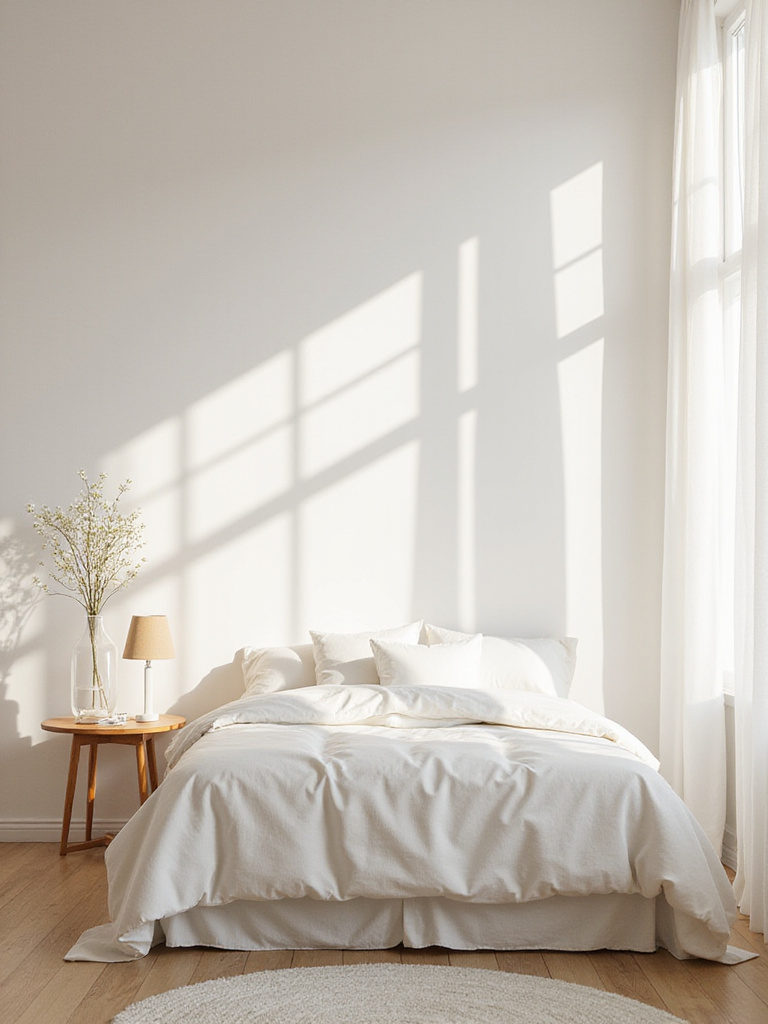
This flexibility is particularly valuable in small spaces where every design choice needs to work harder. Instead of committing to a wall color that might feel dated in two years, white walls give you the freedom to experiment with trends through easily changeable elements. You can embrace seasonal color palettes, try out new design movements, or adapt your space to different life phases without the time and expense of repainting.
- Create mood boards for different styles to see how they work against white walls
- Invest in neutral foundational pieces that can anchor multiple aesthetic directions
- Use removable wallpaper or wall decals for temporary pattern without paint commitment
- Build a collection of throw pillows and blankets in various color palettes for quick switches
Beyond the obvious placement, consider using this flexibility to create seasonal transformations that keep your space feeling fresh year-round.
5. Layer Textures for Visual Depth
White bedroom walls provide the perfect neutral stage for creating rich, layered textures that add warmth and visual interest without overwhelming your small space. When you remove color competition from the walls, textures become the stars of the show—chunky knit throws, smooth ceramic lamps, rough jute rugs, and soft velvet pillows all work together to create a sophisticated, multi-dimensional room.
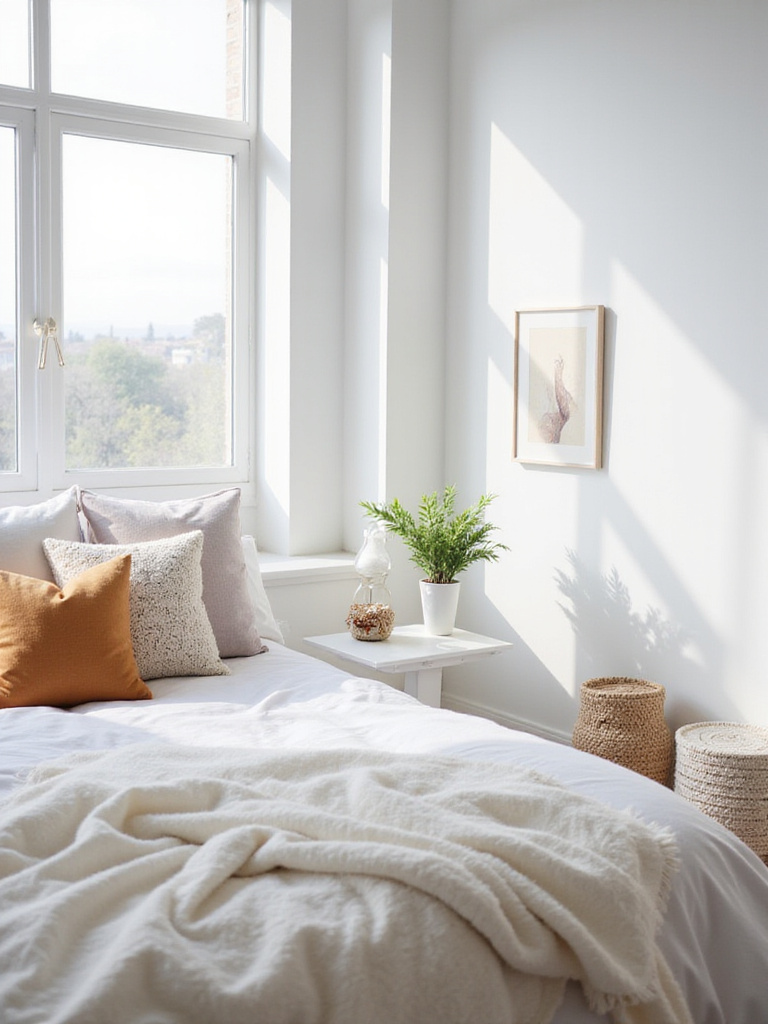
The key to successful texture layering in small spaces is strategic restraint. Rather than filling every surface with different textures, choose three to four distinct texture families and repeat them throughout the room. This creates visual cohesion while adding the tactile richness that prevents white rooms from feeling sterile. The white walls amplify each texture’s unique qualities, making a simple linen curtain feel more luxurious and a wooden nightstand more sculptural.
- Mix smooth and rough textures for contrast (silk pillows with chunky knit throws)
- Include at least one natural fiber element like jute, wool, or cotton
- Vary the scale of textures from fine (smooth ceramics) to large (cable-knit blankets)
- Use lighting to highlight texture variations and create interesting shadows
The visual weight balances perfectly when you introduce metallic accents that catch and reflect light throughout your layered space.
6. Add Warmth with Strategic Metal Accents
Metal finishes bring essential warmth and sophistication to white bedroom walls while maintaining the clean, uncluttered aesthetic that makes small spaces feel larger. Brass, copper, and warm gold tones add just enough richness to prevent white walls from feeling cold or institutional, while their reflective surfaces help bounce additional light around your room.
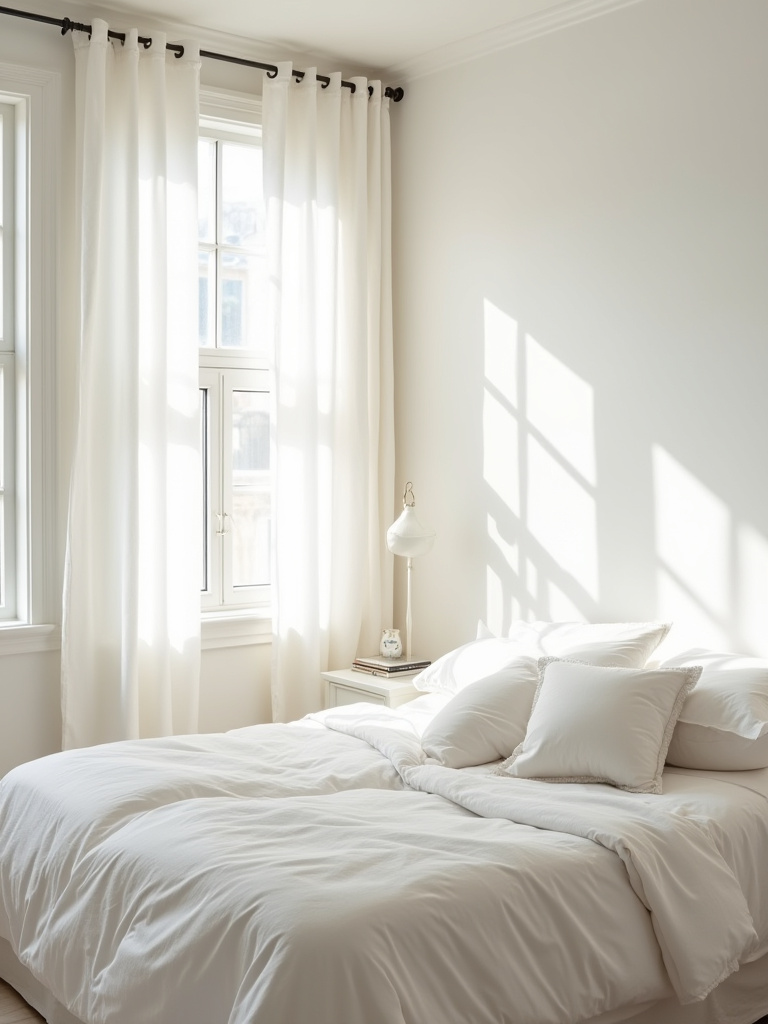
The strategic placement of metal accents creates visual anchors that guide the eye around your space. A brass table lamp here, copper picture frames there, and gold cabinet hardware create a subtle rhythm that adds interest without cluttering. These reflective surfaces work double duty in small spaces—they provide design impact while contributing to the overall brightness and sense of openness that white walls create.
- Choose warm metal tones (brass, copper, gold) over cool ones (chrome, silver) for coziness
- Mix different metal finishes in the same warm family for added depth
- Use metal accents in lighting fixtures to combine function with style
- Include one larger metal piece like a mirror frame or headboard for significant impact
The emotional response this evokes begins with the way morning light filters through and interacts with both the white surfaces and metallic elements.
7. Maximize Natural Light Reflection
White bedroom walls excel at capturing and multiplying whatever natural light enters your space, but maximizing this effect requires strategic thinking about window treatments, furniture placement, and surface finishes. The goal is to create a light-bouncing system that illuminates every corner of your small room, making it feel bright and airy even on cloudy days.

The positioning of reflective surfaces near windows can dramatically increase your room’s perceived brightness. A white-painted wall opposite a window acts like a giant reflector, bouncing light back across the room. When you combine this with strategic mirror placement and light-colored flooring, you create multiple reflection points that amplify available light exponentially.
- Install sheer curtains or light-filtering blinds instead of heavy drapes
- Position mirrors at angles to bounce light into darker corners
- Choose furniture with glossy or semi-gloss finishes to add reflection points
- Keep windows clean and unobstructed during daylight hours
The craftsmanship reveals itself in details like how different white paint sheens interact with light throughout the day.
8. Choose the Right White Paint Finish
Not all white paints are created equal, and the finish you choose can dramatically impact both the functionality and aesthetic of your small bedroom. Matte finishes absorb light and hide imperfections but can be difficult to clean, while semi-gloss finishes reflect maximum light but show every flaw. For most small bedrooms, an eggshell or satin finish provides the perfect balance of light reflection and practicality.
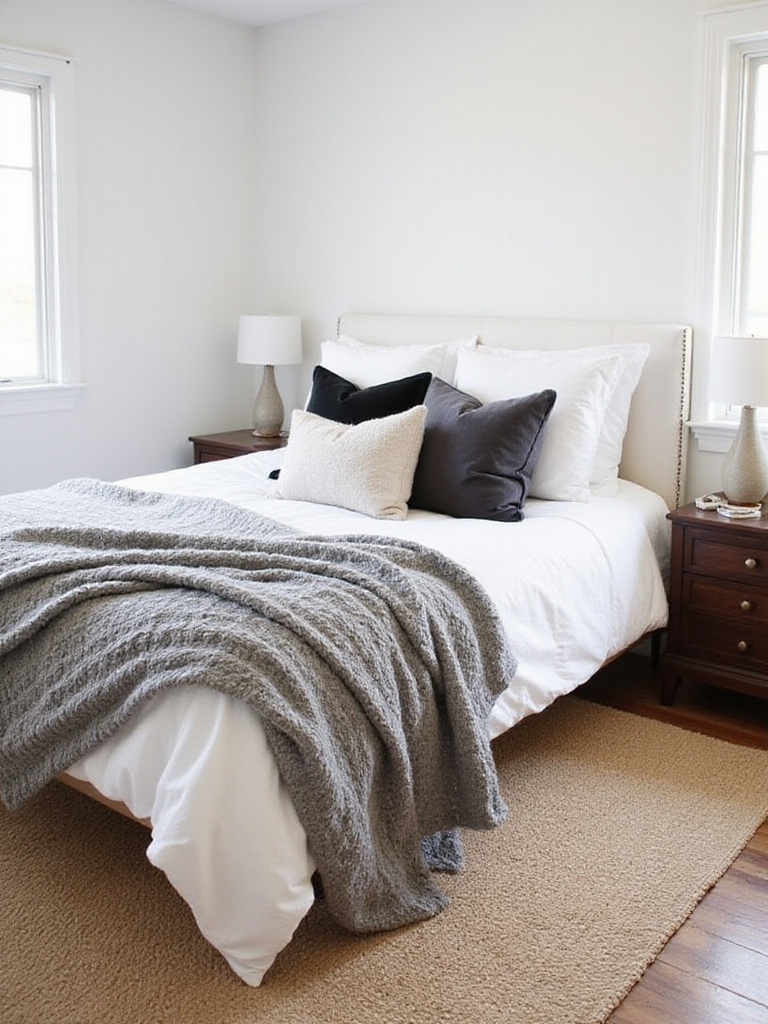
The finish you select also affects how your white walls interact with different lighting conditions throughout the day. A subtle sheen from an eggshell finish adds depth and dimension that pure matte lacks, while still maintaining the soft, sophisticated look that makes small spaces feel serene. This choice becomes even more critical in compact rooms where walls are viewed from multiple angles and distances.
- Test paint samples in different lighting conditions before committing
- Consider eggshell finish for main walls and semi-gloss for trim work
- Factor in your room’s humidity levels when selecting paint durability
- Choose washable formulas for easy maintenance in high-touch areas
The sustainable journey of this material involves understanding how different paint formulations affect both your immediate space and long-term maintenance needs.
9. Create Zones with Subtle White Variations
Using different shades or finishes of white paint allows you to create distinct zones within your small bedroom without the visual weight of contrasting colors. This sophisticated approach maintains the space-expanding benefits of white walls while adding architectural interest and functional definition to different areas of your room.
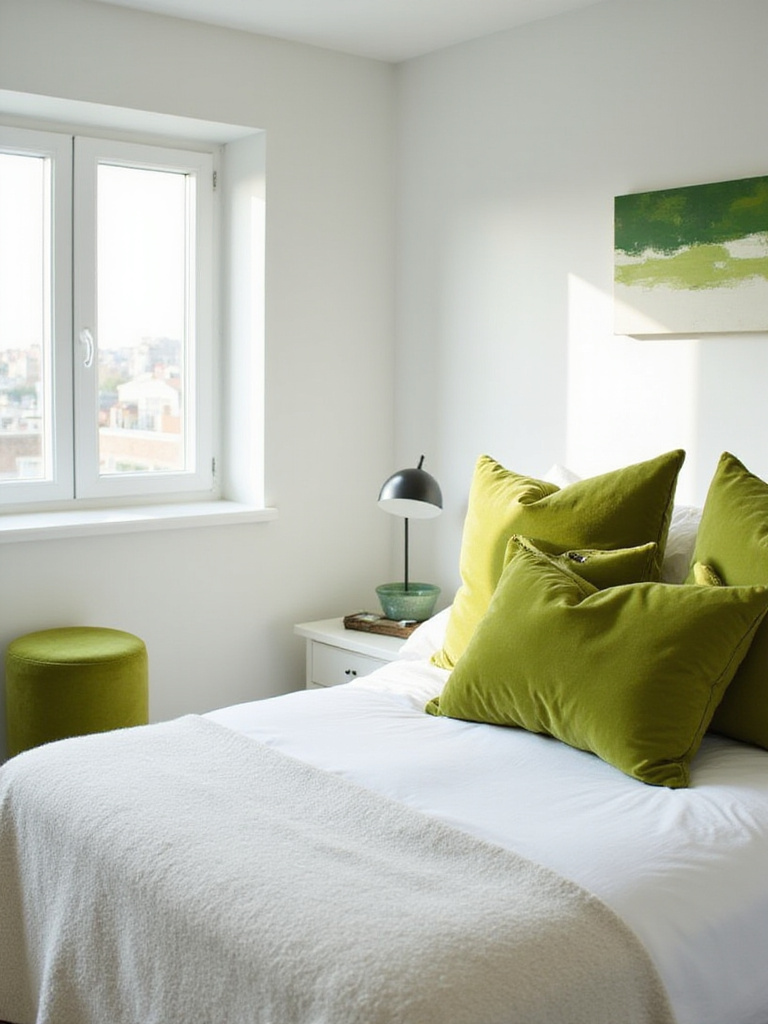
The technique works by using your eye’s ability to detect subtle variations in tone and sheen. A slightly warmer white behind your headboard can define the sleeping area, while a cooler white on the opposite wall might highlight a reading nook or workspace. These gentle transitions create visual interest without the jarring boundaries that colored accent walls can create in small spaces.
- Use the same paint brand to ensure color compatibility between shades
- Test combinations on large sample areas to see how they interact
- Consider using different finishes of the same white for subtle variation
- Maintain consistent undertones (warm or cool) across all white variations
The unexpected pairing that always works is combining these subtle white variations with carefully chosen natural materials.
10. Incorporate Natural Wood Elements
Natural wood elements provide essential warmth and organic texture against white bedroom walls, creating a balanced environment that feels both fresh and inviting. Wood’s natural grain patterns and warm tones prevent white spaces from feeling sterile while adding the kind of authentic character that makes small rooms feel like home rather than hotel rooms.

The biophilic benefits of incorporating natural materials extend beyond aesthetics. Wood surfaces help regulate humidity, absorb sound, and create a connection to nature that promotes relaxation and well-being. In small bedrooms where every element needs to contribute to comfort, these functional benefits make wood an especially valuable addition to your white-walled space.
- Choose wood tones that complement your white’s undertones (warm whites with honey woods, cool whites with ash or maple)
- Mix different wood elements like flooring, furniture, and decorative accessories
- Include both smooth and textured wood finishes for visual variety
- Consider reclaimed or sustainable wood options for added character and environmental benefits
The artisan collective that creates these pieces understands how traditional craftsmanship can enhance modern small-space living.
11. Design a Gallery Wall System
White bedroom walls provide the perfect museum-quality backdrop for creating impactful gallery walls that add personality without overwhelming your small space. Unlike busy or colored backgrounds that compete with artwork, white walls allow your chosen pieces to command full attention while creating the illusion of expanded wall space through strategic visual flow.
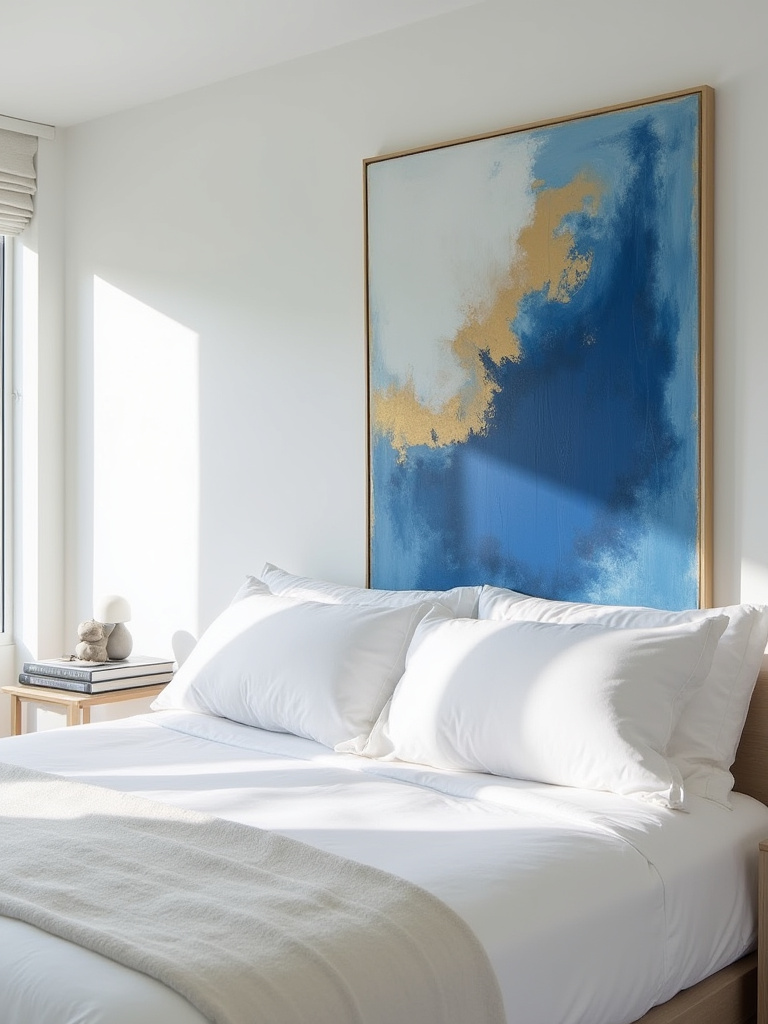
The key to successful gallery walls in small bedrooms is treating them as architectural elements rather than just decoration. A well-planned gallery wall can draw the eye upward, making ceilings feel taller, or horizontally, making walls feel wider. The white background unifies disparate pieces into a cohesive collection that feels intentional and sophisticated.
- Start with paper templates to plan your layout before making holes
- Include a mix of sizes and orientations for dynamic visual rhythm
- Maintain consistent spacing (2-3 inches) between pieces for professional look
- Choose frames that complement each other without being identical
The composition comes together when you balance the visual weight of your artwork with the negative space that white walls provide.
12. Use White Walls for Better Sleep
The psychological impact of white bedroom walls extends far beyond aesthetics—they actively contribute to better sleep quality by creating a calm, uncluttered visual environment that helps your mind wind down. Unlike stimulating colors that can increase alertness, white walls promote the mental quietude necessary for restful sleep, especially important in small bedrooms where visual calm is essential.
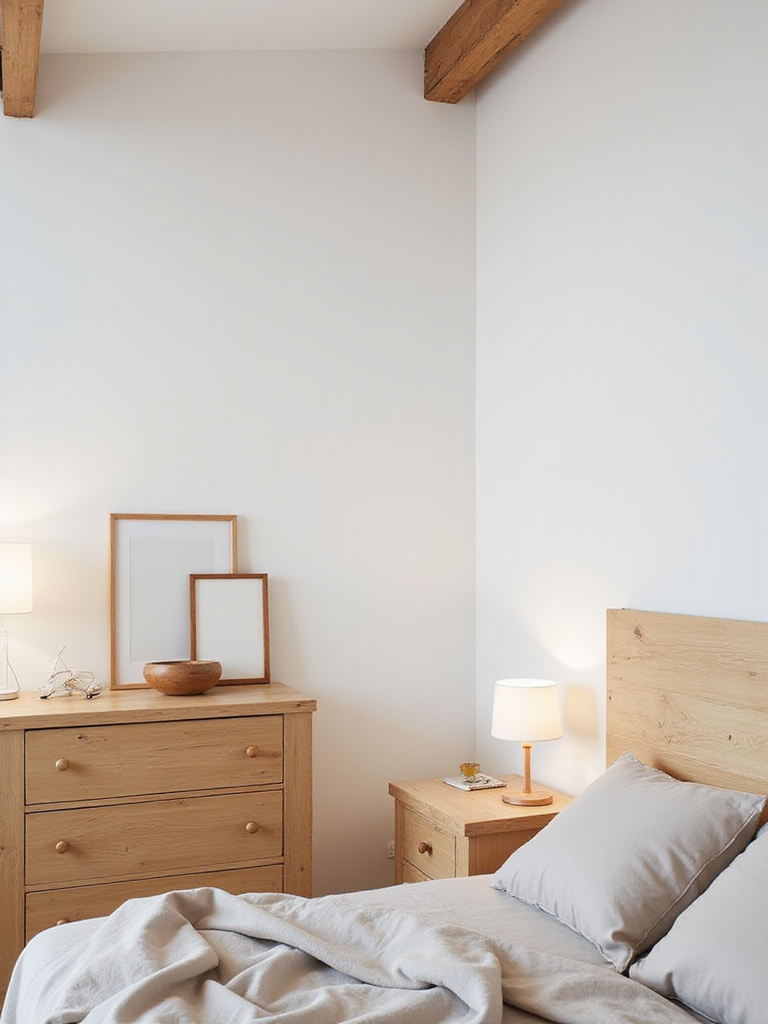
Research in color psychology confirms that neutral environments reduce cognitive stimulation and promote relaxation. White walls eliminate visual distractions that might keep your mind active when you’re trying to sleep. This becomes particularly valuable in small spaces where you might be dealing with urban noise or light pollution—white walls help create a cocoon-like sanctuary that supports healthy sleep patterns.
- Choose warm white tones over stark cool whites for evening comfort
- Combine white walls with blackout curtains for optimal sleep darkness
- Minimize contrasting elements that might create visual stimulation
- Use soft, warm lighting in the evening to complement the calming white environment
The quality becomes evident after years of use when you realize how much more rested you feel in this thoughtfully designed space.
13. Simplify Small Space Maintenance
White bedroom walls significantly simplify the maintenance and upkeep of small spaces by providing a clean, consistent backdrop that makes dust, dirt, and clutter immediately visible—encouraging regular cleaning habits that keep your compact room feeling fresh and organized. This visibility is actually an advantage, as it prevents the gradual accumulation of mess that can make small spaces feel chaotic.
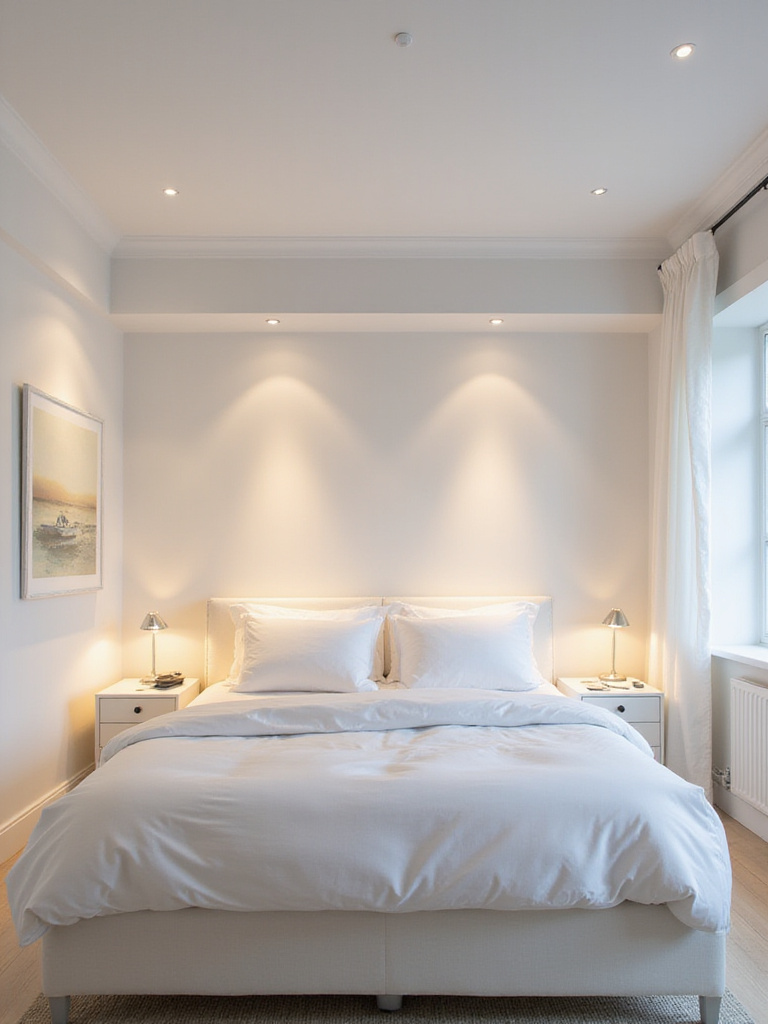
The practical benefits extend to long-term maintenance as well. White paint is universally available, making touch-ups and repairs straightforward and affordable. When you inevitably need to fill nail holes, cover scuffs, or refresh high-traffic areas, matching white paint is simple compared to trying to recreate custom colors or complex finishes years later.
- Keep a small container of your exact white paint for quick touch-ups
- Establish weekly dusting routines that white walls make more effective
- Use washable paint finishes in areas prone to fingerprints or marks
- Document your paint color and brand for future reference
The investment value comes from the exceptional durability and timeless appeal that makes white walls a smart long-term choice.
14. Enhance Architectural Features
White bedroom walls serve as the perfect backdrop for highlighting existing architectural details while creating the illusion of additional architectural interest in plain rooms. Crown molding, chair rails, window casings, and built-in elements all gain prominence when contrasted against crisp white backgrounds, adding perceived value and sophistication to small spaces.
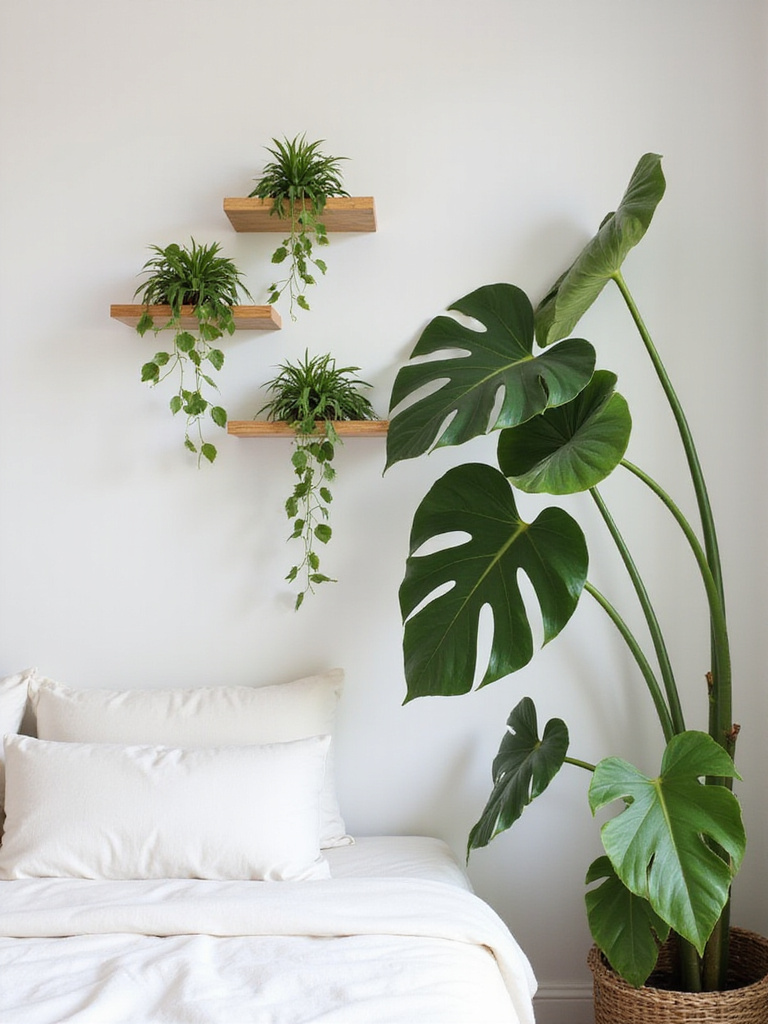
For rooms lacking architectural character, white walls provide the neutral foundation needed to add faux elements like decorative molding, wainscoting, or accent trim without overwhelming the space. These additions feel natural and intentional against white backgrounds, creating the kind of custom millwork look that makes small bedrooms feel more expensive and thoughtfully designed.
- Paint trim in a slightly different white or subtle contrast color for definition
- Add picture molding or chair rails to create visual interest on plain walls
- Use white to unify mismatched architectural elements into a cohesive look
- Highlight beautiful existing features like exposed beams or built-in shelving
The heritage technique gets a contemporary update through the strategic use of white paint to bridge traditional architectural elements with modern small-space needs.
15. Create Seasonal Flexibility
White bedroom walls provide the ultimate foundation for seasonal decorating, allowing you to transform your small space’s mood and energy throughout the year without major renovations or expenses. This adaptability is particularly valuable in compact rooms where storage space for seasonal decor is limited—you can achieve dramatic changes with just a few key pieces.
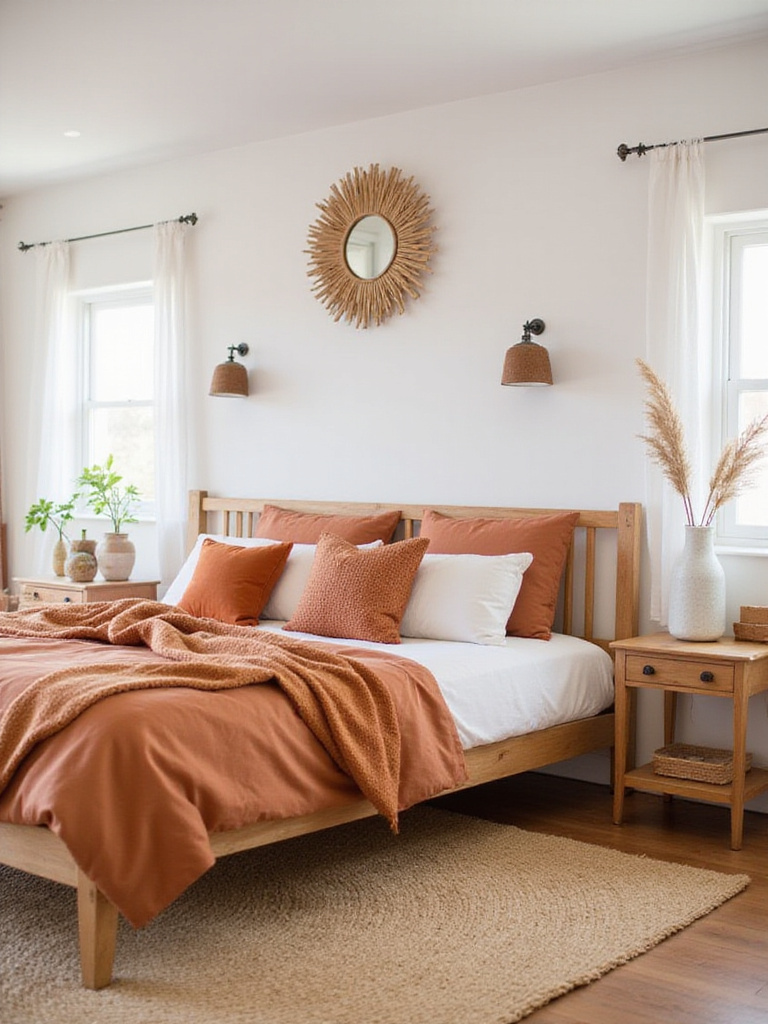
The neutral backdrop of white walls means that seasonal color palettes always work harmoniously. Deep jewel tones for fall and winter feel rich and cozy, while light pastels and bright colors for spring and summer feel fresh and energizing. This flexibility allows you to use your bedroom as a tool for combating seasonal mood changes and keeping your space feeling current year-round.
- Store seasonal textiles in under-bed boxes or vacuum-sealed bags
- Choose seasonal scents and candles to enhance color-based mood changes
- Rotate artwork or photographs to reflect seasonal themes
- Use lighting temperature changes (warmer in winter, cooler in summer) to enhance seasonal effects
The forecast for next season already hints at how this foundational approach will continue serving your evolving style needs.
16. Maximize Vertical Space Perception
White bedroom walls excel at drawing the eye upward, creating the illusion of height that makes small bedrooms feel more spacious and less cramped. This vertical emphasis is achieved through the uninterrupted flow of white paint from floor to ceiling, eliminating horizontal breaks that would otherwise segment the wall and make it appear shorter.

The technique becomes even more powerful when you add vertical elements like tall, narrow artwork, floor-to-ceiling curtains, or vertical storage solutions. Against white walls, these elements create strong vertical lines that pull the eye upward and make even standard eight-foot ceilings feel lofty and grand. This perceived height expansion is crucial in small bedrooms where horizontal space is limited.
- Hang curtains from ceiling to floor, even if windows are smaller
- Choose tall, narrow furniture pieces over wide, low ones when possible
- Use vertical stripe patterns sparingly to enhance the height effect
- Install floating shelves in vertical arrangements rather than long horizontal runs
The mood shifts dramatically when you add carefully chosen plants that bring life and natural beauty to your white-walled sanctuary.
17. Showcase Indoor Plants Effectively
White bedroom walls create the perfect backdrop for indoor plants, making every green leaf and colorful bloom pop with vibrant intensity. This contrast effect means you can achieve maximum visual impact with fewer plants—crucial in small bedrooms where floor space is at a premium. The clean white background makes even simple plants look like carefully curated design elements.
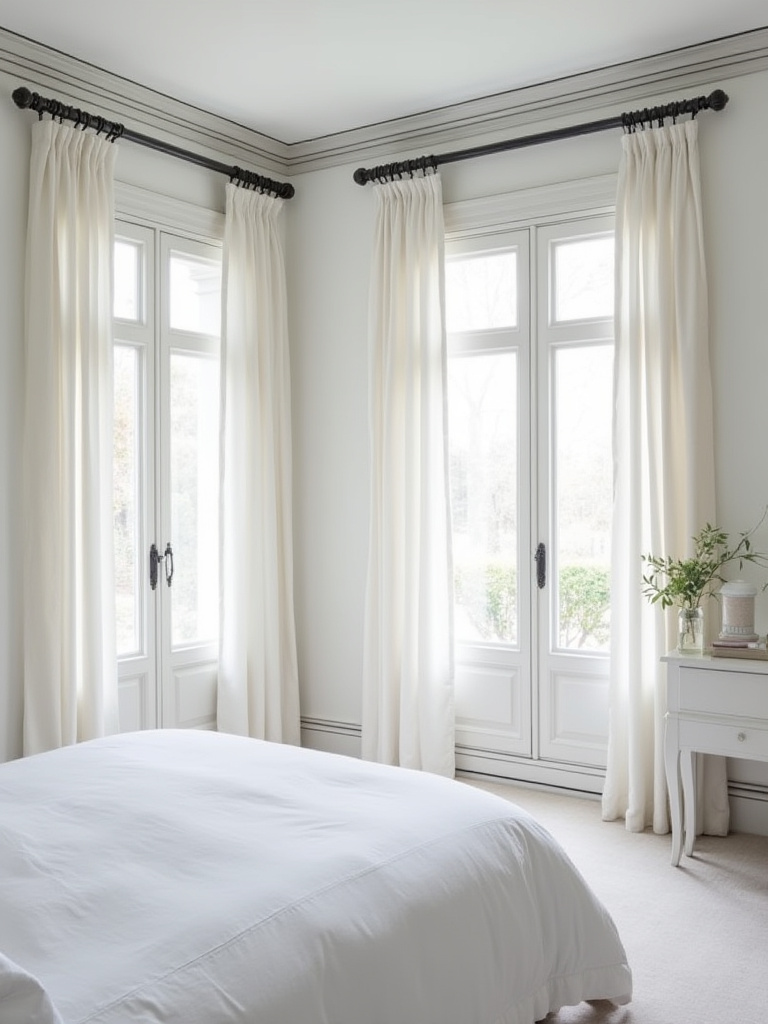
The health benefits of plants become even more pronounced in small bedrooms, where air circulation might be limited. Plants help purify the air while adding the kind of natural beauty that makes compact spaces feel more livable and less confined. Against white walls, plants also create interesting shadow patterns as light moves throughout the day, adding dynamic visual interest to your space.
- Choose plants with interesting leaf shapes and textures for maximum visual impact
- Use hanging planters to add greenery without sacrificing floor space
- Group plants at different heights for a layered, professional look
- Select low-maintenance varieties that thrive in bedroom lighting conditions
The environmental story behind this piece began with understanding how white walls can support sustainable decorating practices.
18. Support Sustainable Decorating Practices
White bedroom walls align perfectly with sustainable decorating practices by providing a timeless foundation that reduces the need for frequent redecorating and waste generation. Instead of following color trends that quickly become dated, white walls encourage investment in quality pieces that will look beautiful for years to come, supporting a more mindful approach to small space design.

The longevity of white walls also supports the principles of slow decorating—making thoughtful, intentional choices rather than impulse purchases. When you know your walls will work with anything, you can take time to find pieces you truly love rather than settling for items that simply match a temporary color scheme. This approach is both environmentally responsible and financially smart for small space dwellers.
- Invest in quality, timeless pieces rather than trendy, disposable decor
- Choose multi-functional items that serve multiple purposes in small spaces
- Support local artisans and sustainable manufacturers when possible
- Focus on durability and repairability when selecting furniture and accessories
Conclusion
The transformative power of white bedroom walls extends far beyond simple aesthetics—they’re a strategic design choice that can revolutionize how your small space looks, feels, and functions. From maximizing every ray of natural light to creating the perfect backdrop for your evolving style, white walls offer unmatched versatility and timeless appeal that grows with you over time.
What makes white walls particularly brilliant for small spaces is their ability to solve multiple design challenges simultaneously. They make rooms feel larger, brighter, and more expensive while providing the flexibility to experiment with different styles, seasons, and moods without costly renovations. This combination of immediate impact and long-term value makes white walls one of the smartest investments you can make in your small bedroom.
Whether you’re starting fresh in a new space or looking to maximize the potential of your current bedroom, these 18 strategies provide a roadmap for creating the bright, spacious, and personalized sanctuary you deserve. Your perfect small bedroom retreat is just a gallon of white paint and some thoughtful design choices away.
